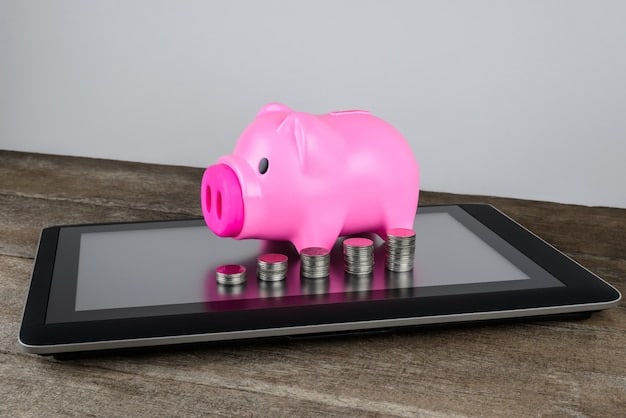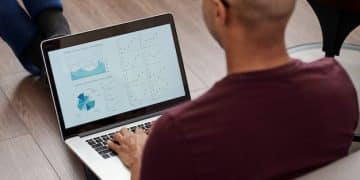Student Loan Debt Relief: Navigating Federal Programs & Requirements

Navigating the complex landscape of student loan debt relief requires understanding the latest federal programs and strict adherence to their specific eligibility requirements to effectively manage and potentially reduce financial burdens.
For millions across the United States, managing student loan debt has become a significant financial challenge, often feeling like an inescapable burden. While the landscape of debt relief is constantly evolving, understanding the latest federal programs and their specific requirements is paramount. This guide aims to demystify student loan debt relief: navigating the latest federal programs and requirements, providing clarity and actionable insights to help borrowers find their path to financial alleviation. Whether you’re struggling with payments, seeking forgiveness, or simply curious about options, this comprehensive overview can serve as your essential resource.
Understanding the Federal Student Loan Ecosystem
The federal student loan system is vast and complex, comprising various loan types, repayment plans, and potential relief options. Before diving into specific relief programs, it’s crucial to grasp the fundamental structure of these loans. Federal student loans, unlike private loans, offer a range of benefits and borrower protections, including income-driven repayment plans, deferment, forbearance, and various forgiveness programs. These protections are key to understanding why federal relief efforts primarily target these types of loans.
Each federal loan type—Direct Subsidized Loans, Direct Unsubsidized Loans, Direct PLUS Loans, and Direct Consolidation Loans—comes with its own rules regarding interest accrual, eligibility for certain benefits, and overall repayment terms. Understanding which types of loans you hold is the first step in identifying applicable relief programs. For instance, some forgiveness programs are exclusively available to Direct Loan borrowers, while others might include older Federal Family Education Loan (FFEL) Program loans or Perkins Loans.
Types of Federal Student Loans and Their Characteristics
Federal student loans are generally grouped by their origin and how interest is handled. Subsidized loans are based on financial need, with the government paying interest while the student is in school, during grace periods, and during deferment. Unsubsidized loans are not need-based, and interest accrues from the moment the loan is disbursed.
- Direct Subsidized Loans: For undergraduate students with demonstrated financial need; government pays interest during certain periods.
- Direct Unsubsidized Loans: Available to undergraduate and graduate students; interest accrues from disbursement.
- Direct PLUS Loans: For graduate/professional students or parents of dependent undergraduates; credit check required.
- Direct Consolidation Loans: Combines multiple federal loans into one, simplifying payments and potentially extending repayment terms.
The distinction between these loan types is vital because it often dictates eligibility for specific relief measures. Borrowers with older FFEL or Perkins loans may need to consolidate them into a Direct Consolidation Loan to qualify for certain new or expanded federal programs, highlighting the importance of understanding your loan portfolio deeply.
Navigating this initial stage can be overwhelming, but resources like the Federal Student Aid (FSA) website provide comprehensive information on individual loan balances, types, and servicers. This foundational knowledge empowers borrowers to make informed decisions when exploring the various avenues of student loan debt relief.
Income-Driven Repayment (IDR) Plans: Your Path to Affordable Payments
For many borrowers, the most accessible form of federal student loan relief comes through Income-Driven Repayment (IDR) plans. These plans are designed to make loan payments more manageable by capping them at a percentage of your discretionary income, typically between 10% and 20%. The idea is to ensure that your student loan payment doesn’t consume an unreasonable portion of your earnings, especially for those with lower incomes compared to their debt burden.
The U.S. Department of Education offers several IDR plans, each with slightly different terms and conditions: Income-Based Repayment (IBR), Pay As You Earn (PAYE), Revised Pay As You Earn (REPAYE), and Income-Contingent Repayment (ICR). The newest addition, the Saving on a Valuable Education (SAVE) Plan, is rapidly becoming a significant option for borrowers due to its potentially lower payments and more generous interest subsidy rules.
Key Features and Benefits of IDR Plans
IDR plans offer several important benefits beyond just lowering monthly payments. One of the most significant advantages is that any remaining loan balance is forgiven after 20 or 25 years of qualified payments, depending on the specific plan and whether you have graduate or undergraduate loans. This forgiveness is particularly attractive for those with high debt-to-income ratios.
- Affordable Payments: Payments are adjusted annually based on income and family size.
- Interest Subsidy: Some IDR plans, like SAVE, prevent unpaid interest from capitalizing (being added to your principal balance), which can lead to rapid balance growth.
- Loan Forgiveness: Remaining balances are forgiven after a specified period of eligible payments, typically 20 or 25 years.
- Protection Against Default: By making payments affordable, IDR plans help borrowers avoid default, which has severe consequences for credit and future financial opportunities.
The SAVE Plan, which fully replaced the REPAYE Plan, aims to significantly reduce monthly payments for many borrowers and prevent interest from accumulating beyond what is covered by the reduced payment. This means that if your payment on the SAVE Plan is $0, or less than your accrued interest, the government will cover the difference, preventing your principal balance from increasing.
Enrolling in an IDR plan requires an application, and borrowers must recertify their income and family size annually. Failing to recertify can lead to higher payments and accrued interest capitalizing. It’s a proactive measure that requires ongoing attention but offers substantial relief for qualified individuals. Understanding which IDR plan best suits your financial situation is crucial, and the Federal Student Aid website provides valuable tools to compare plans and estimate payments.

Loan Forgiveness and Discharge Programs: Specific Pathways to Zero Balance
Beyond IDR plans, several federal programs offer pathways to full or partial loan forgiveness or discharge, often tied to specific professions, circumstances, or periods of service. These programs are distinct from IDR forgiveness and generally have stricter eligibility criteria but can provide a more direct route to eliminating student debt for qualified individuals.
The most widely known forgiveness program is Public Service Loan Forgiveness (PSLF). This program is designed to encourage individuals to enter and remain in public service jobs by forgiving the remaining balance on Direct Loans after 120 qualifying monthly payments while working full-time for a qualifying employer. Qualifying employment includes government organizations (federal, state, local, or tribal) and eligible non-profit organizations.
Exploring Key Forgiveness and Discharge Options
Each forgiveness or discharge program serves a specific purpose, addressing different borrower needs or societal contributions. It’s essential to carefully review the criteria for each to determine eligibility.
- Public Service Loan Forgiveness (PSLF): Requires 10 years of qualifying public service employment and 120 on-time payments under a qualifying repayment plan.
- Teacher Loan Forgiveness: For teachers who work for five complete, consecutive academic years in a low-income school or educational service agency; up to $17,500 in forgiveness available.
- Total and Permanent Disability (TPD) Discharge: For borrowers who are completely and permanently disabled, preventing them from engaging in any substantial gainful activity.
- Borrower Defense to Repayment Discharge: For borrowers whose school engaged in misconduct, such as misleading them about job prospects or educational quality.
- Closed School Discharge: For borrowers who could not complete their program because their school closed while they were enrolled or shortly after withdrawing.
Recent changes and temporary waivers, such as the PSLF waiver implemented during the pandemic, have broadened eligibility and made it easier for more borrowers to qualify for PSLF by counting previously ineligible payments. Staying informed about these temporary flexibilities is crucial, as they can significantly impact your path to forgiveness.
Successfully applying for these programs often involves meticulous record-keeping, especially for PSLF, which requires annual certification of employment and income. While the process can be demanding, the reward of eliminating student loan debt can be life-changing for eligible borrowers. It’s important to differentiate between these programs and the forgiveness associated with IDR plans, as they have different requirements and timelines.
Temporary Relief Measures and Pauses: Lessons from the Pandemic
The COVID-19 pandemic brought about unprecedented changes to federal student loan repayment, most notably a widespread payment pause and zero interest rate that lasted for over three years. While these measures were temporary, they offered a critical lifeline to millions of borrowers and reshaped expectations regarding government intervention in student loan debt.
The payment pause, which began in March 2020 and concluded in September 2023, effectively halted payments and interest accrual on most federal student loans. This period also counted towards loan forgiveness programs like PSLF and IDR, even without payments being made, providing substantial benefits to borrowers on those tracks. It demonstrated the government’s capacity to implement broad-based relief during times of crisis.
Impact and Future Implications of Payment Pauses
The extended payment pause not only provided immediate financial relief but also allowed many borrowers to improve their financial standing, pay down other debts, or save money. It also highlighted the fragility of many borrowers’ financial situations when faced with regular student loan payments.
- Financial Breathing Room: Borrowers had more disposable income for other expenses or savings.
- Forgiveness Progress: Months during the pause counted towards PSLF and IDR forgiveness timelines.
- Increased Awareness: The pause brought student loan issues to the forefront, increasing public and political awareness of the debt crisis.
- Transition Challenges: The end of the pause created significant challenges for borrowers returning to repayment, leading to calls for more permanent solutions.
While the broad payment pause has ended, its legacy continues to influence policy discussions around student loan relief. It underscored the potential for government action to alleviate financial strain and set a precedent for how future economic downturns or crises might be addressed. Borrowers should remain vigilant for any future temporary measures, though they are not guaranteed or regularly scheduled.
The lessons learned from the pandemic’s relief efforts are being integrated into new and existing programs, such as the improvements to IDR plans like the SAVE Plan. This shift reflects a move towards more targeted, sustainable relief rather than universal short-term pauses, emphasizing the importance of understanding available ongoing programs rather than relying on future temporary interventions.
Avoiding Scams and Navigating Official Channels
In the complex and often confusing world of student loan debt relief, it’s unfortunate that scams are prevalent. unscrupulous companies and individuals often prey on desperate borrowers, promising quick fixes or guaranteed forgiveness for a fee. Recognizing and avoiding these scams is as crucial as understanding legitimate relief options.
Legitimate federal student loan relief programs are always free to apply for directly through the U.S. Department of Education or your authorized loan servicer. No reputable program will ever ask you to pay an upfront fee for services that you can perform yourself, such as consolidating loans, applying for an IDR plan, or seeking forgiveness.
Red Flags of Student Loan Scams
Protecting yourself from scams involves recognizing common tactics used by fraudulent companies. If something sounds too good to be true, it likely is, especially when it comes to debt relief.
- Requests for Upfront Fees: Legitimate aid is free; never pay to apply for or get federal loan relief.
- Guaranteed Forgiveness: No company can guarantee loan forgiveness; eligibility depends on specific criteria you must meet.
- Pressure to Act Immediately: Scammers often create a sense of urgency to bypass your critical thinking.
- Requests for FSA ID/Password: Never share your Federal Student Aid (FSA) ID or password. This is your personal identifier for federal student aid programs.
- Unofficial Contact Methods: Be wary of unsolicited calls, emails, or texts claiming to be from the Department of Education or your loan servicer.
The U.S. Department of Education and your loan servicer are the only authoritative sources for information about your federal student loans and available relief. Always verify information directly with these official channels,
rather than relying on third-party solicitations. If you suspect a scam, report it to the Federal Trade Commission (FTC) and your state’s attorney general.
Official communication about federal student loans will typically come from “U.S. Department of Education,” “Federal Student Aid,” or your specific loan servicer (e.g., Nelnet, MOHELA). Familiarize yourself with their official websites and contact information and always initiate contact through verified channels rather than responding to suspicious outreach. Your diligence is your best defense against loan relief scams.
Preparing For and Managing Repayment After Relief
Even with relief programs, managing student loans is an ongoing process. Once you’ve identified and potentially qualified for a relief program, the next crucial step is to strategically prepare for and manage your repayment. This involves understanding your new payment terms, budgeting, and knowing how to stay compliant with program requirements.
For those transitioning off a payment pause or entering an IDR plan, ensuring your contact information is up to date with your loan servicer is paramount. Misplaced mail or email can lead to missed deadlines and potential forfeiture of benefits. Setting up automatic payments can also prevent missed payments, which is especially important for programs like PSLF that require consistent, on-time payments.
Effective Strategies for Post-Relief Repayment
A proactive approach to managing your student loans post-relief can greatly reduce stress and ensure long-term financial stability. It’s not just about making payments, but understanding the intricacies of your chosen program and planning ahead.
- Budgeting and Financial Planning: Integrate your new student loan payment into your monthly budget to ensure affordability.
- Annual Recertification (for IDR Plans): Mark your calendar for annual income and family size recertification; failure to do so can result in higher payments.
- Monitor Your Loan Account: Regularly check your loan servicer’s website for updates, payment history, and loan balance information.
- Keep Records: Maintain detailed records of all communication with your servicer, payments made, and any certifications for forgiveness programs.
- Understand Tax Implications: Forgiveness amounts can sometimes be considered taxable income, though some forms of forgiveness (like PSLF) are tax-exempt. Consult a tax professional.
The journey through student loan debt relief is often a long one, requiring patience, persistence, and continuous engagement with your loan servicer and the Department of Education. It’s critical to be prepared for the complexities that may arise and to seek expert advice when needed. Whether it’s adjusting to a new payment, preparing for a future tax obligation from forgiven debt, or simply staying on track with certifications, ongoing vigilance is key to successfully navigating your student loan journey.

The Future of Student Loan Debt Relief: What to Expect
The landscape of student loan debt relief is dynamic, constantly evolving with changes in political priorities, economic conditions, and public demand. While the past few years have seen significant temporary and permanent adjustments, predicting the exact future is challenging. However, certain trends and ongoing discussions can offer insights into what borrowers might expect moving forward.
One clear trend is the increased emphasis on income-driven repayment plans, particularly the new SAVE Plan, as the primary mechanism for making federal student loans more affordable and providing a path to forgiveness. This suggests a move away from one-time blanket forgiveness initiatives towards structured programs that adjust to an individual’s financial capacity over time.
Anticipated Developments and Policy Discussions
Several key areas are likely to see continued debate and potential reform in the coming years. These discussions are largely driven by the ongoing challenges faced by millions of borrowers and the broader economic implications of student debt.
- Further IDR Refinements: Policymakers may continue to refine IDR plans, potentially lowering discretionary income percentages or shortening forgiveness timelines for certain groups.
- Targeted Forgiveness: Beyond PSLF, there might be expanded or new targeted forgiveness programs for specific professions facing critical shortages or for borrowers with particularly old debts.
- Loan Servicing Oversight: Increased scrutiny and potential reforms in how loan servicers operate to improve borrower experiences and reduce administrative errors.
- Addressing Loan Interest: Ongoing debates about how interest accrual impacts loan balances, potentially leading to new policies to mitigate interest growth.
- Higher Education Accountability: A continued focus on holding colleges and universities accountable for student outcomes and reducing the need for excessive borrowing.
While the prospect of broad-based student loan forgiveness remains a topic of considerable political debate, the current focus appears to be on strengthening existing programs and implementing administrative relief measures that directly benefit borrowers already struggling or those in critical public service roles.
This ongoing dialogue underscores the importance of staying engaged and informed. Reliable sources such as the Federal Student Aid website, reputable financial news outlets, and consumer advocacy groups can help borrowers keep pace with evolving policies. Being proactive in monitoring these developments ensures that you are aware of any new opportunities or changes that could impact your student loan repayment strategy.
| Key Relief Programs | Brief Description |
|---|---|
| ✅ Income-Driven Repayment (IDR) | Payments based on income and family size, with potential forgiveness after 20-25 years. Includes the new SAVE Plan. |
| 💼 Public Service Loan Forgiveness (PSLF) | Loan balance forgiven after 120 qualifying payments while working in public service. |
| 🏫 Teacher Loan Forgiveness | Up to $17,500 forgiveness for teachers in low-income schools after 5 years of service. |
| ♿ Total & Permanent Disability (TPD) Discharge | Discharge of loans for borrowers who can no longer work due to permanent disability. |
Frequently Asked Questions
▼
The SAVE Plan (Saving on a Valuable Education) is the newest Income-Driven Repayment plan, replacing REPAYE. It calculates payments based on a smaller percentage of discretionary income and offers a more generous interest subsidy, preventing unpaid interest from capitalizing and causing your principal balance to grow. It aims to significantly lower monthly payments for many borrowers.
▼
PSLF is for borrowers with Direct Loans who work full-time for a qualifying government or non-profit organization. You must make 120 qualifying monthly payments under a qualifying repayment plan. It’s crucial to ensure your employer qualifies and to certify your employment annually through the PSLF Help Tool on the Federal Student Aid website.
▼
Yes, you may be eligible for a Closed School Discharge if your school closed while you were enrolled or within a certain period after you withdrew. This applies if you did not complete your program and did not transfer your credits to another school within specific timeframes. Contact your loan servicer for details on eligibility and application.
▼
If you suspect a student loan scam, first, avoid providing any personal information or payments. Then, report the scam to the Federal Trade Commission (FTC) at ReportFraud.ftc.gov and your state Attorney General. Do not share your FSA ID or password with anyone. Always communicate directly with your official loan servicer or the U.S. Department of Education.
▼
Yes, if you are enrolled in an Income-Driven Repayment (IDR) plan, you must recertify your income and family size annually. Your loan servicer will send you a reminder when it’s time to recertify. Failing to recertify on time can result in your monthly payments increasing and any unpaid interest capitalizing, adding to your principal balance.
Conclusion
Navigating the complex world of student loan debt can be daunting, but with the right knowledge and proactive engagement, meaningful relief is within reach. The federal government offers a diverse array of programs, from income-driven repayment plans like the transformative SAVE Plan to specialized forgiveness options for public servants and teachers, and discharges for those facing severe hardship. Understanding your loan types, diligently exploring eligibility criteria, and staying informed about evolving policies are critical steps. By leveraging these resources and remaining vigilant against scams, borrowers can chart a clearer path toward financial stability and ultimately, alleviate the burden of student loan debt.





